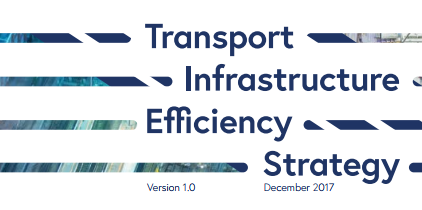Transport infrastructure efficiency strategy
On 6 December 2017 the Department for Transport, High Speed Two (HS2) Limited, and Highways England published a Transport infrastructure efficiency strategy (TIES), describing seven challenges that the Department for Transport and its delivery bodies will address to improve transport infrastructure efficiency.
This followed a series of other significant announcements for the construction industry:
- 22 November 2017, Autumn Budget 2017.
- 27 November 2017, Industrial Strategy: building a Britain fit for the future.
- 29 November 2017, details of the Construction Sector Deal.
- 6 December 2017, Transforming Infrastructure Performance.
The challenges which will be addressed to improve transport infrastructure efficiency and provide better outcomes for transport users, as set out in the strategy are:
- Judge strategic choice and trade-offs - based on whole life costs and wider benefits.
- Improve the way we set up our projects - to maximise value and prevent inefficiency throughout delivery.
- Create a transport infrastructure performance benchmarking forum - to share best practice and innovation.
- Establish a common approach - to estimating to improve cost confidence and assurance.
- Promote long-term, collaborative relationships - with industry to reduce transaction costs in procurement and maximise innovation.
- Challenge standards - to enable innovation and drive efficiencies.
- Exploit digital technologies and standardise our assets - to enable the adoption of best practice from the manufacturing sector, such as off-site construction.
The strategy suggests that addressing these challenges will better enable Crossrail, Highways England, HS2 Ltd, Network Rail, TfL and the DfT to meet efficiency targets and increase the certainty offered to the supply chain about how transport bodies want their infrastructure to be delivered. Those organisations are also pledging to support the vision of the Construction Leadership Council (CLC) to transform productivity within the construction sector
Andrew Wolstenholme, (then CEO of Crossrail and co-chair of the Construction Leadership Council (CLC)) will Chair a Transport Infrastructure Efficiency Taskforce (TIET), to support each of the bodies involved with implementing their own responses to the strategy. The TIET will provide the framework, oversight, challenge and coordination for the workstreams identified in the strategy and will also provide a One Year On report on progress.
Chris Grayling, Secretary of State for Transport said; “If we are to succeed, we must pursue efficiency - making sure that transport users get the best possible return on every pound we spend on our transport networks."
Andrew Wolstenholme said; “When we first started working on the Strategy we set ourselves the modest ambition of sharing lessons learnt and case studies from how we invest in transport infrastructure. Having done that, we have now set ourselves seven key challenges. Responding to these challenges will also support the Construction Leadership Council and wider construction sector to deliver better productivity by aligning incentives and ambitions between clients and the supply chain.”
[edit] Related articles on Designing Buildings Wiki
- Autumn Budget 2017.
- Balanced scorecard.
- Construction 2025.
- Construction industry organisation.
- Construction Leadership Council.
- Construction sector deal.
- Construction Sector Deal launch.
- Government construction strategy.
- Industrial Strategy: building a Britain fit for the future.
- Infrastructure and Projects Authority.
- Modern methods of construction.
- Transforming Infrastructure Performance.
- Transport subsidies are unsustainable: what next for infrastructure.
Featured articles and news
The Building Safety Forum at the Installershow 2025
With speakers confirmed for 24 June as part of Building Safety Week.
The UK’s largest air pollution campaign.
Future Homes Standard, now includes solar, but what else?
Will the new standard, due to in the Autumn, go far enough in terms of performance ?
BSRIA Briefing: Cleaner Air, Better tomorrow
A look back at issues relating to inside and outside air quality, discussed during the BSRIA briefing in 2023.
Restoring Abbotsford's hothouse
Bringing the writer Walter Scott's garden to life.
Reflections on the spending review with CIAT.
Retired firefighter cycles world to raise Grenfell funds
Leaving on 14 June 2025 Stephen will raise money for youth and schools through the Grenfell Foundation.
Key points for construction at a glance with industry reactions.
Functionality, visibility and sustainability
The simpler approach to specification.
Architects, architecture, buildings, and inspiration in film
The close ties between makers and the movies, with our long list of suggested viewing.
SELECT three-point plan for action issued to MSPs
Call for Scottish regulation, green skills and recognition of electrotechnical industry as part of a manifesto for Scottish Parliamentary elections.
UCEM becomes the University of the Built Environment
Major milestone in its 106-year history, follows recent merger with London School of Architecture (LSE).
Professional practical experience for Architects in training
The long process to transform the nature of education and professional practical experience in the Architecture profession following recent reports.
A people-first approach to retrofit
Moving away from the destructive paradigm of fabric-first.
International Electrician Day, 10 June 2025
Celebrating the role of electrical engineers from André-Marie Amperè, today and for the future.
New guide for clients launched at Houses of Parliament
'There has never been a more important time for clients to step up and ...ask the right questions'
The impact of recycled slate tiles
Innovation across the decades.
EPC changes for existing buildings
Changes and their context as the new RdSAP methodology comes into use from 15 June.

























